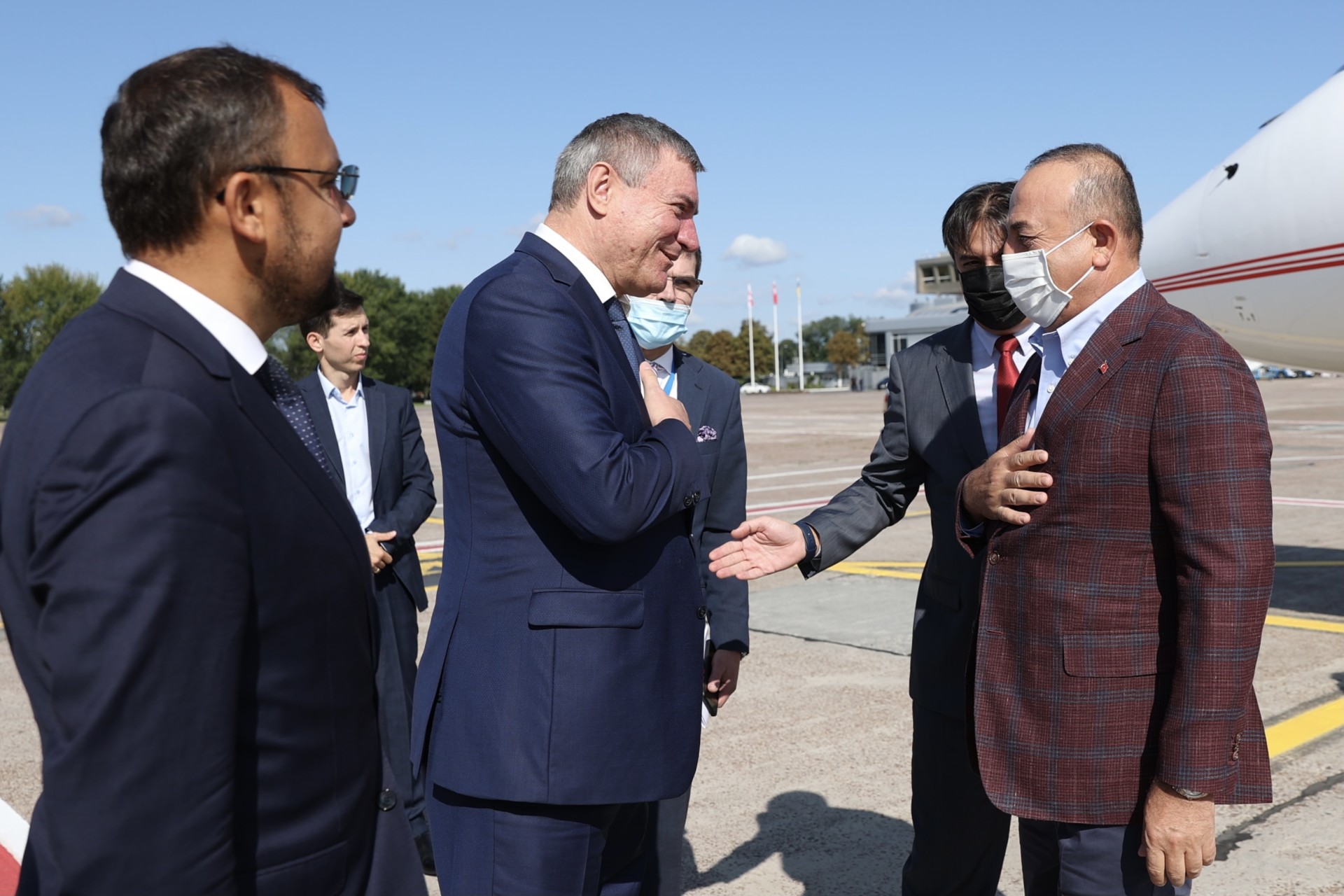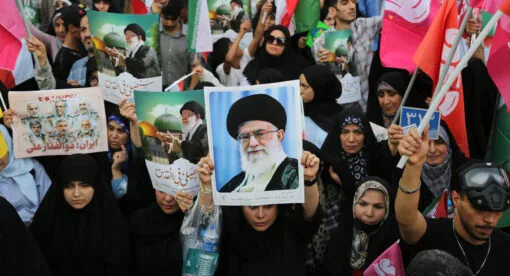Instead of focusing on Ukraine’s accession to the EU and NATO, Kyiv, Brussels, and Washington should prioritize internal reforms and diversifying Ukraine’s foreign policy.
Ukrainian President Volodymyr Zelenskyy will visit Washington on Sep. 1 to meet with U.S. President Joe Biden to shore up political support for Ukraine’s Western integration efforts. Kyiv has struggled to reach its primary foreign policy goal of gaining membership in the EU and NATO, underlining the need for a new strategy for the country’s Western integration. Instead of focusing on accession to the EU and NATO, Kyiv, Brussels, and Washington should prioritize reforms and democratization within Ukraine and build the country’s economic, security, and political connectivity with the West while diversifying its ties to other key parts of Eurasia. In the long term, such efforts will strengthen Ukraine’s institutional resilience, offer greater protection from Russia, and make it a more effective partner for the West.
Ukraine is the epitome of a borderlands state. Located between the European Union to the west and Russia to the east, it has been on the front line of the geopolitical tug of war between Moscow and the West since it gained independence. This was seen most clearly in the 2014 EuroMaidan revolution in Kyiv, which ousted a pro-Russian government in favor of a Western-oriented one. These events subsequently triggered Russia’s annexation of Crimea and set off a deadly separatist conflict in Eastern Ukraine that continues to this day.
Since EuroMaidan, Ukraine’s foreign policy priority has been political, economic, and security integration with the West, including seeking membership in both the EU and NATO as a defensive and institutional bulwark against Russia. However, several factors have caused these bids to fall short. One is Ukraine’s domestic challenges: While Kyiv has passed reforms in areas like the energy sector and the judiciary, the country still faces key shortcomings related to corruption, the influence of Russia-connected oligarchs, and the rule of law that do not yet meet the standards of these Western blocs. Another factor is enlargement fatigue in parts of the EU, which has only grown stronger in the post-Brexit environment. While countries like Poland and the Baltic states support Ukraine’s EU accession, such fatigue is particularly strong among core states like Germany and France. A third factor is the ongoing conflict in Eastern Ukraine, which stems from Russia’s imperative to keep Ukraine within its own sphere of influence. If Ukraine were to gain NATO membership, the bloc’s Article 5 provision would immediately pull it into a direct military confrontation with Moscow-aligned forces – and even if Article 5 was not triggered, staging NATO forces inside Ukraine risks a major escalation of the Russia-West standoff – making many member states resistant to Kyiv’s accession.
Ukraine, the U.S., and the EU do have key strategic imperatives in common; each of these actors wants a strong and stable Ukrainian state that can defend itself against Russia and is well integrated into Western institutions. However, each player (as well as each of the constituent members of EU) has its own preferences and constraints in how that can be achieved and what exactly that integration looks like. This has undermined the integration process as a whole, leaving it vulnerable to domestic constraints within Ukraine, as well as external challenges such as Russian interference.
A New Foreign Policy Paradigm
Given these realities, these parties should adopt a new paradigm for Ukraine’s Western integration in order to strengthen the country’s position, one that rests on a three-pronged strategy. The first prong is for Kyiv and the West to drop – or at least to de-emphasize – the explicit goal of Ukraine’s membership in the EU and NATO. This is not to say that Ukraine’s efforts at economic and security integration with the West should be abandoned – only the rhetorical component of seeking EU and NATO membership, which has exacerbated tensions with Russia while not bringing Ukraine any closer to actual membership.
The second prong is to build functional and tactical integration between Ukraine and the West. This would consist of expanding Ukraine’s existing infrastructure connectivity with European countries – including pipelines, grids, roads, and railways – and conducting domestic reforms that build institutional resilience. Ukraine’s experience has shown that focusing on the end goal of membership in the EU and NATO before completing the hard work of integration and domestic institutional strengthening can have dangerous consequences. As such, a conditions-based system in which Ukraine’s successful completion of reforms are tied to direct financial and other forms of assistance from the EU and U.S. would be beneficial in making progress toward such goals. For example, the U.S. and EU can make economic support for Ukraine conditional upon successful reform implementation in fields like regulatory harmonization and decarbonization of its energy sector while facilitating closer tactical economic and military cooperation based on such reform implementation.
The final prong is for Ukraine to diversify its relationships, focusing not only westward toward Europe and the U.S. as a counterweight to Russia but also across other key nodes of Eurasia. One particularly important player in this regard is Turkey, which represents not only a large and influential country in its own right that can act as a third vector but also one that can leverage its strategic transcontinental position to serve as a nexus for Ukraine into resource-rich Caucasus and Central Asia. Turkey can serve as a transit point for energy resources like oil and natural gas to further diversify Ukraine’s energy inputs and provide it with diplomatic and security support. Indeed, this is already happening to a certain extent, as Ukraine and Turkey have been in preliminary discussions on joint energy projects, while Ukraine has increased Turkish weapons purchases.
Such a diversification of partners and connectivity corridors would take Ukraine out of the traditional Russia/West dichotomy, which has only led to zero sum-conflict between the two blocs, and replace it with a multi-nodal competition that can yield mutually beneficial results. Indeed, such an approach can be seen in the case of one of Ukraine’s fellow former Soviet states. Azerbaijan, in the post-Soviet era, has dealt with a separatist conflict in Nagorno-Karabakh but unlike Ukraine has refused to exclusively integrate with either the West or Russia as a foreign policy strategy. This strategy also distinguished Azerbaijan from its neighbors in the Caucasus, with Georgia orienting itself toward the EU and NATO while Armenia aligned itself with Russia, and both have paid a heavy price as a result.
Instead, Baku has balanced between the two blocs. In the early post-Soviet period, Azerbaijan turned to the U.S. and other Western countries to help develop its energy infrastructure and diversify its exports outside of Russia while maintaining economic and security cooperation with Russia. In the meantime, it developed a strong relationship with Turkey, which enabled Azerbaijan to send its energy supplies westward and – through newly built infrastructure like the BTC and BTE pipelines along the Southern Energy Corridor – farther on to Europe.
Azerbaijan used its diplomatic and security connections with Turkey when it challenged Armenia’s control of Nagorno-Karabakh in late 2020 – a move that drew international condemnation and allegations of war crimes. Baku’s reclamation of substantial territory in and around the disputed region happened outside of the framework of EU/NATO integration while also avoiding direct clashes with Russia, despite Moscow being allied with Armenia. Now, Azerbaijan is attempting to leverage its recent territorial gains to build further infrastructure connections in the region, though such plans will be shaped by ongoing political and security frictions with Armenia.
Looking Ahead
Of course, there are key differences between the case of Azerbaijan and that of Ukraine: Baku is farther away from Europe geographically and has never seriously entertained joining the EU, while its own record on democracy is even further removed from Western standards. Moreover, Turkey is unlikely to challenge Russia’s position in Eastern Ukraine to the extent that it did in Nagorno-Karabakh (though Ukraine recently received its first delivery of the very TB2 drones that Azerbaijan used in the late-2020 war).
However, the Azerbaijani comparison is nevertheless important for Ukraine on a strategic level in terms of foreign policy diversification and balancing. To introduce a legitimate third vector for Kyiv that is not a formal alliance system, but rather one that is informal and has functional components that addresses Ukraine’s concrete needs of energy diversification, can bring high rewards with relatively low risk. For Ukraine, such a strategy of diversification would not replace its Western integration priorities but rather would make them more concrete and practical while building them in tandem with other connections that are functional as opposed to political alliances. In this case, Ukraine could look to Poland and the Baltic states (and perhaps one day Belarus) as a logical regional connectivity corridor, just as Turkey, the Caucasus, and Central Asia (and potentially China) can serve as another supplemental and complementary corridor.
Such an approach is not without its own challenges. Russia is aware of the benefits of Ukraine’s diversification of energy resources, and it is in Moscow’s interest to prevent other external powers from wielding influence in Ukraine (which is why Russia opposes Kyiv’s integration with the West). This explains Moscow’s pursuit of projects such as the Nord Stream 2 pipeline, which aim to weaken Ukraine’s role as a strategic transit state. In this case, it is in the EU and U.S. interest to support Ukraine’s diversification beyond the Russia/West paradigm.
Thus, when it comes to Ukraine’s integration with the West, what is important for all sides moving forward is to deepen infrastructural and institutional connections beyond the exclusive framework of EU and NATO membership. Significant progress has already been made in certain areas, but there is still much work to do. On the domestic front in Ukraine, this involves sustainable reforms that last beyond specific individuals and governments, reflecting the values of a stable socio-political culture committed to democracy and the rule of law. On the external front, this involves a nimble balancing of various players, without overreliance on or overextension to any one of them.
In the end, Ukraine could actually be better positioned to join the EU and NATO if it pursues this multi-pronged strategy, as it will have done all the hard work toward integration and built up leverage with other players in the process. More importantly, it would strengthen Ukraine’s domestic and external standing and put it in a better position to deal with Russia. Such an outcome would represent a true marker of success born from the EuroMaidan revolution.
Eugene Chausovsky is a Nonresident Fellow with the Newlines Institute. Previously, he served as Senior Eurasia Analyst at Stratfor for 10 years. His work focuses on political, economic, and security issues pertaining to the former Soviet Union, Europe, and Latin America. He Tweets at @EugeneChausovsk.
The views expressed in this article are those of the author and not an official policy or position of the Newlines Institute.






